| By: Paul S. Cilwa | Viewed: 5/17/2024 Occurred: 5/15/2011 |
Page Views: 955 | |
| Topics: #Kipahulu #Haleakala #Maui #Hawaii | |||
| Jason and I travel around Mount Haleakala from shore to summit, enjoy a spectaular sunset and break the key to our camper. | |||
Kipahulu is a point at the shore where the volcano Haleakala meets the sea. It, and the summit of Mount Haleakala, are both contained within Haleakala National Park. However, in order to get from one to the other, one must either leave the park and re-enter it from another point, or hike.
We chose to drive.
Dawn found us at the Kipahulu campground in our rented camper, ready to explore.
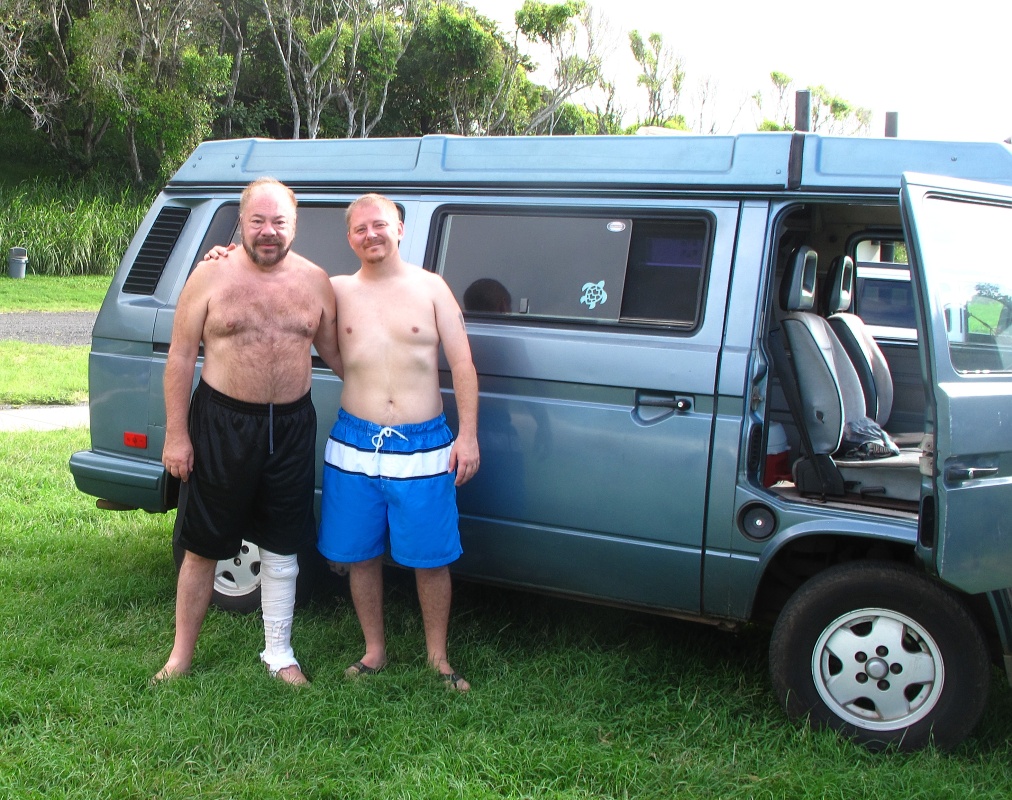
With my leg still bandaged, I wasn't quite ready for a long walk here. I wanted to save my strength for later. So Jason took the camera out to the water's edge, passing a giant, multi-trunked Banyan tree ("people were camping under it so I didn't go in") and the lava rocks on which he found curious jumping crabs.
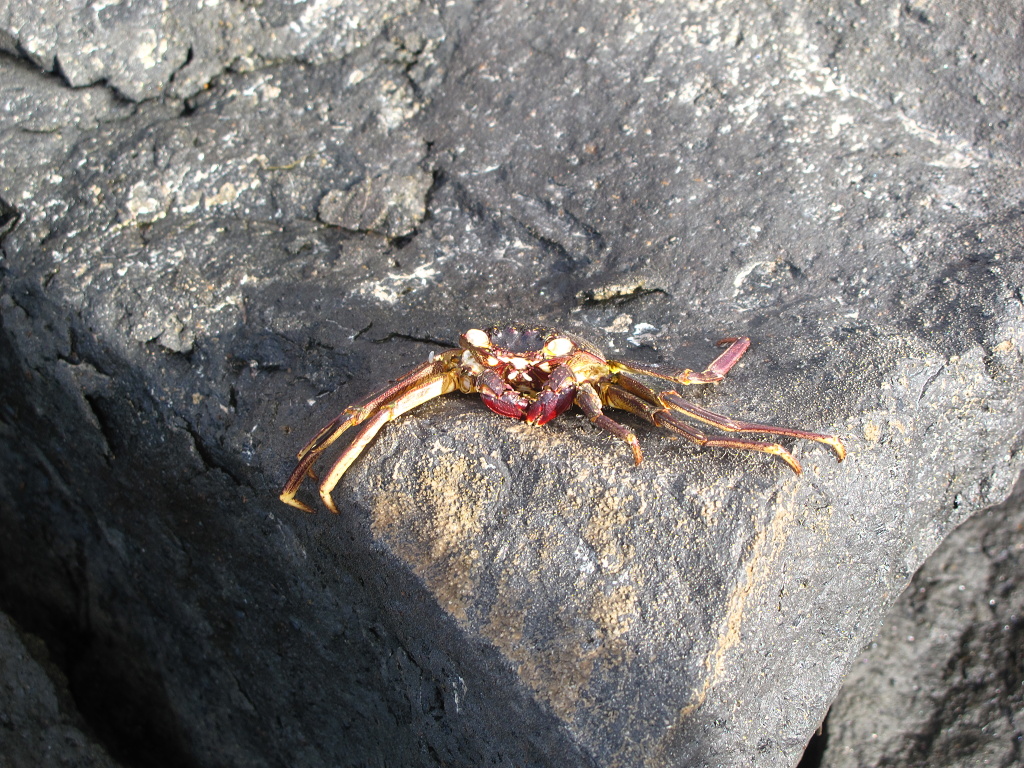
Then we set out in the direction of Hana, from which we'd come, for breakfast. There had to be restaurants open in Hana in the morning but we couldn't find any. We finally stopped at a gas station for convenience-store snacks to hold us over until we could find one, and kept driving.
Just before one gets to Hana—or, in the direction we were traveling, just after—is Wai'anapanapa State Park, a spot we'd investigated the previous night as a possible camping place. We couldn't stay there since we didn't have a permit, which can only be purchased at another location on weekdays. But it is open as a park during the day, and has a black sand beach, which fascinated Jason. So we stopped there to enjoy a swim and take a shower before continuing our search for the elusive breakfast nook.
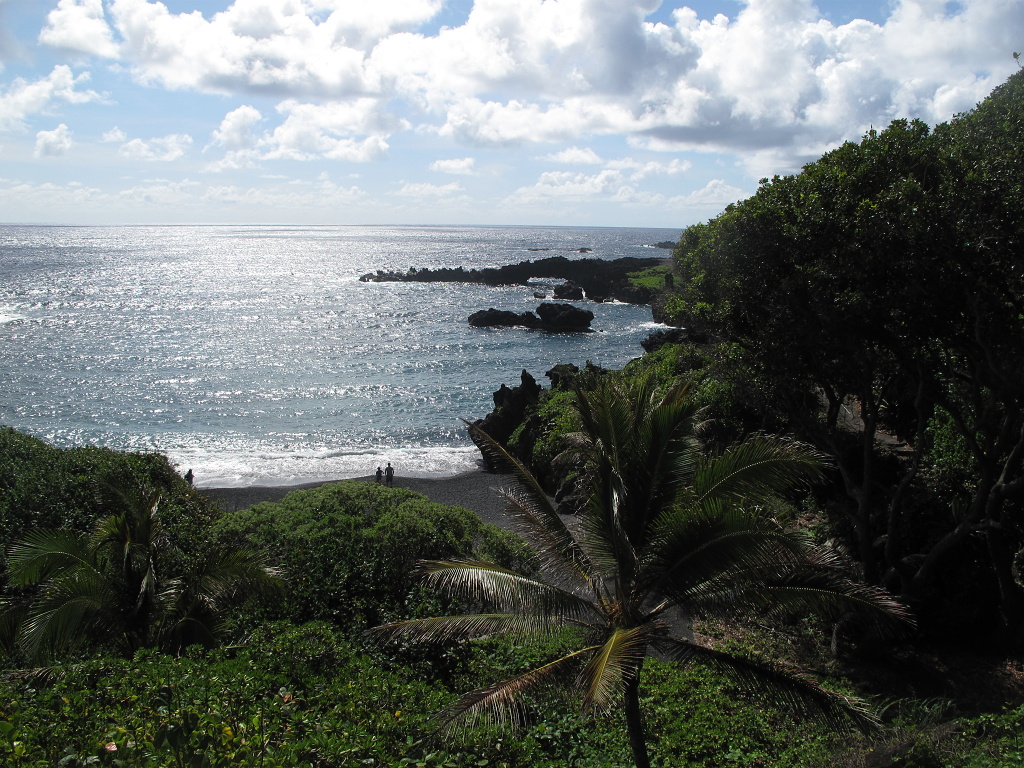
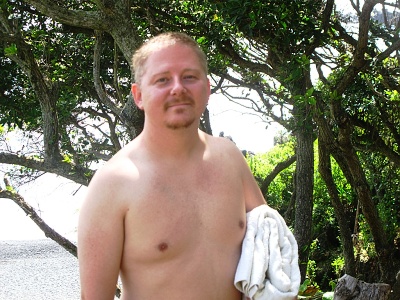
The trail down to the beach was well-maintained and easy to traverse, even with my leg. Of course, I couldn't go into the water, but I made sure Jason understood he could. He would be swimming for us both, and he was ready!
Sand is simply rock that has been pulverized by millions of years of pounding by ocean waves. Sand takes on the color of the pulverized rock. Since the prevailing type of rock on Maui is black lava, there are a number of black sand beaches; and Wai'anapanapa had one of them.
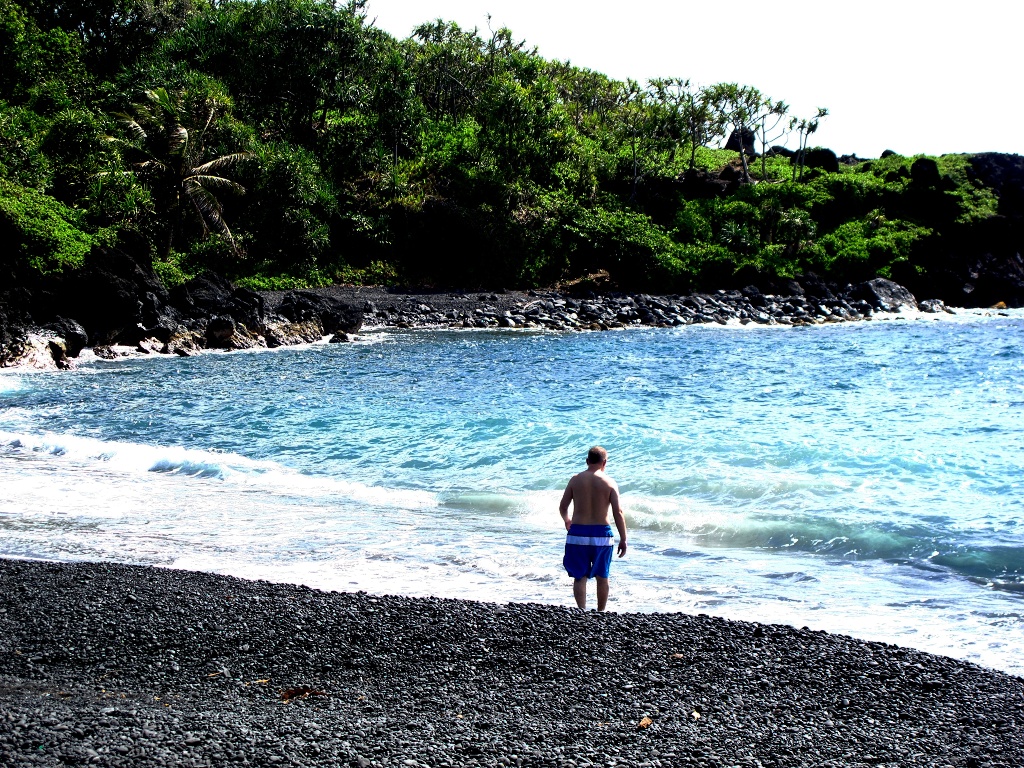
It was great seeing Jason enjoy himself in the cool, but not cold, waters of the Pacific. The beach was in a protected cove so there were gentle waves but no dangerous currents.
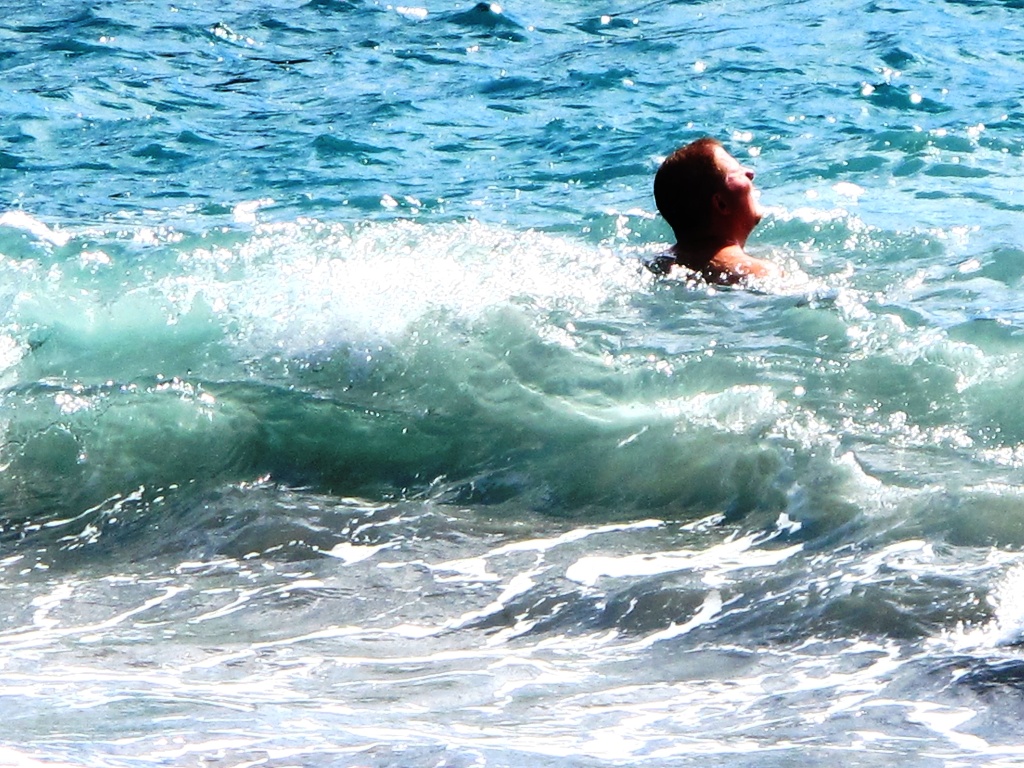
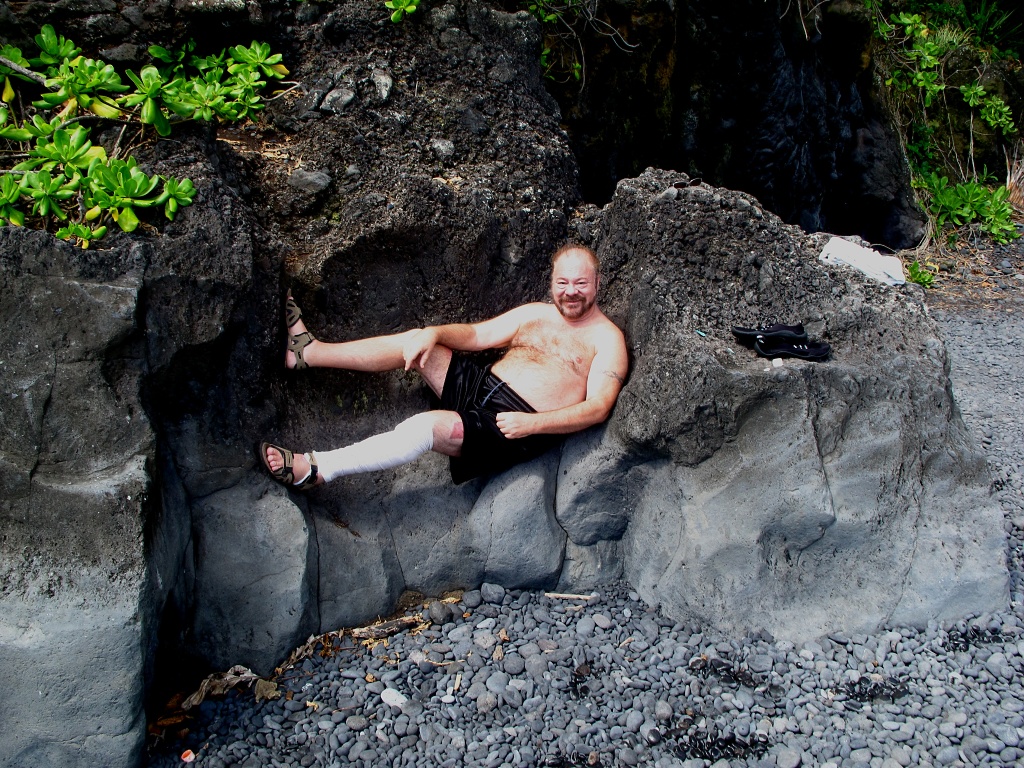
Meanwhile, I relaxed in the Hawaiian sun on a comfortable lava ledge. (It was more comfortable than it looks in the photo!) This ledge was on the outside of an outcropping of lava that actually contained a lava tube, as I discovered when a woman walked past me into the hillside and never came back.
The tube opened onto the beach, just behind me, and the entrance required a bit of a stoop but the tube opened up beyond that, making standing upright possible.
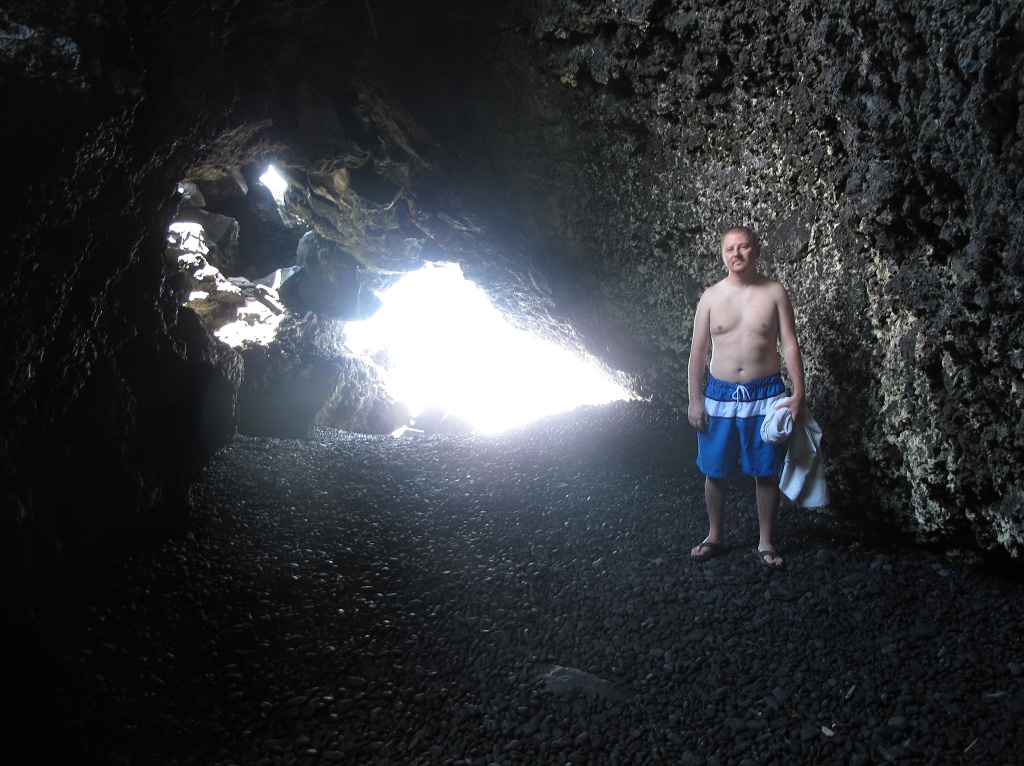
At the far end of the tube was a spectacular view of the shore.
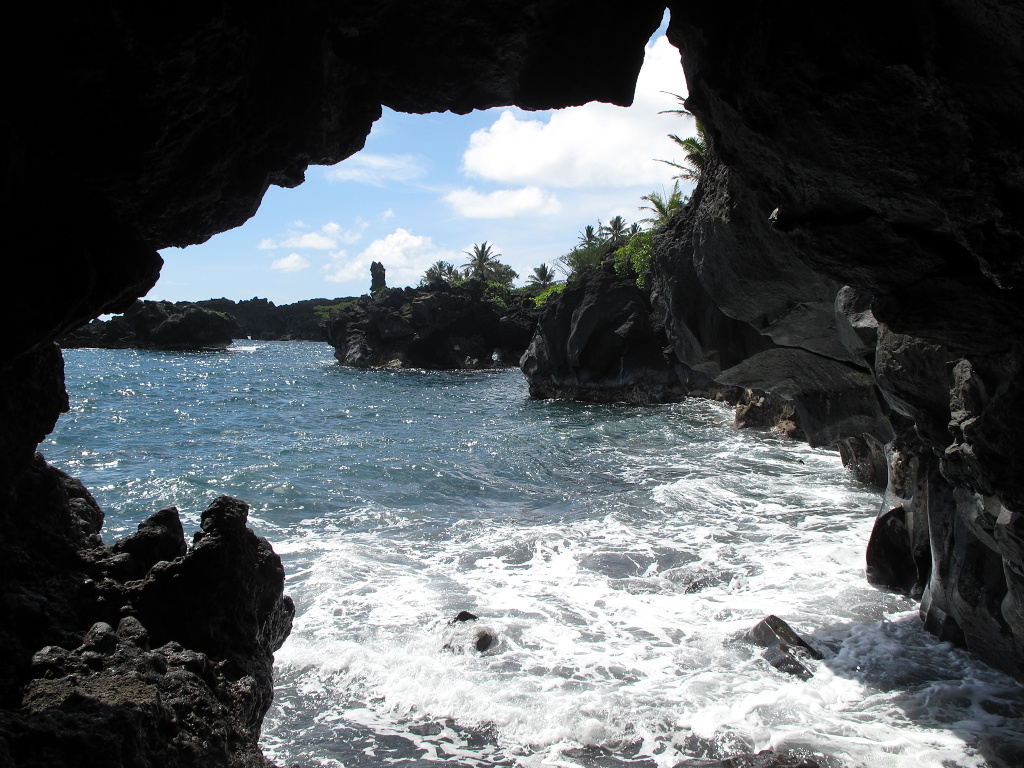
Swimming and caving were fun, of course; but our main reason for coming here was to take showers. When I visited Maui two years ago, I didn't take one and I was here for three nights and four days. I was not very popular on my flight back to the mainland. This time, I was determined to make use of the many beach and park showers available on the island, both for my sake (to change the dressing on my leg) and for Jason's. (For some reason, Jason has no objectionable body odor but even though he insists I don't…I do.)


Jason, who has been changing my dressing pretty much every day since I got out of the hospital, did so at a convenient picnic table. This was the first time I'd needed to change the dressing "in the wild" but we had everything we needed in a handy Zip-Loc sack and the process went smoothly. How to keep my healing leg clean and dressed had been my secret worry regarding the trip; but Jason managed it with aplomb.
So, refreshed, clean, and dressed for the day, Jason and I drove back to the highway and finally found breakfast—of a sort—at a roadside stand, one of many on the highway, where we bought mango bread, bananas, and fresh coffee.
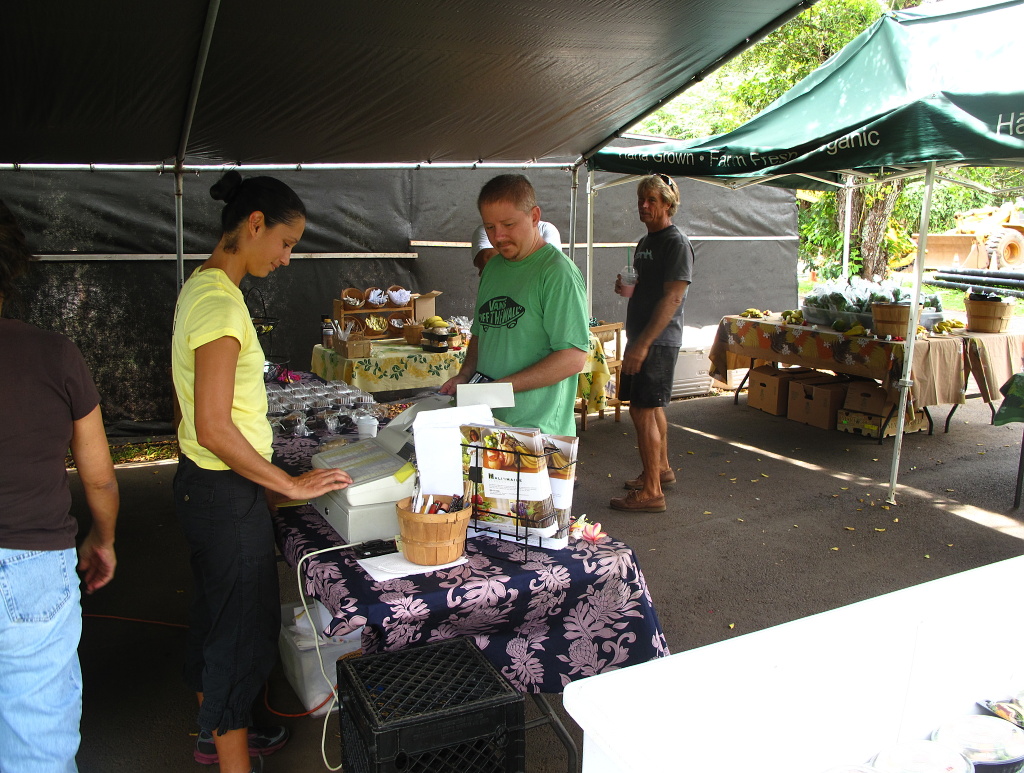
The guy in the picture above, behind Jason, seemed to be just another customer. However when Jason and I sat to eat at a picnic table adjacent to the stand, he joined us, uninvited. On previous trips I'd made by myself, I would have welcomed the chance to speak to a stranger and hear his or her stories…and then blog them.
However, to my surprise, when I started to speak with this guy, Jason became extremely upset. I was willing to end the conversation for Jason's sake; but the guy just wouldn't stop talking and I resented this intrusion…especially when the guy insisted on talking politics, an aspect of the mainland I really wanted to get away from. Not even the fact that he lived in a tent somewhere nearby could get me to warm up to him.
However later, as we drove back towards Kipahulu, Jason asked, "Could you live in a tent?"
"Here? With you?" I laughed. "In a heartbeat!" And so began our earnest conversation considering the possibility of our someday moving to Maui.
Jason, who had been born and raised in the Greater Phoenix area, was fascinated by the casually rustic living arrangements of the locals, in which a horse pasture might be located adjacent to an artist's combination residence and gallery.
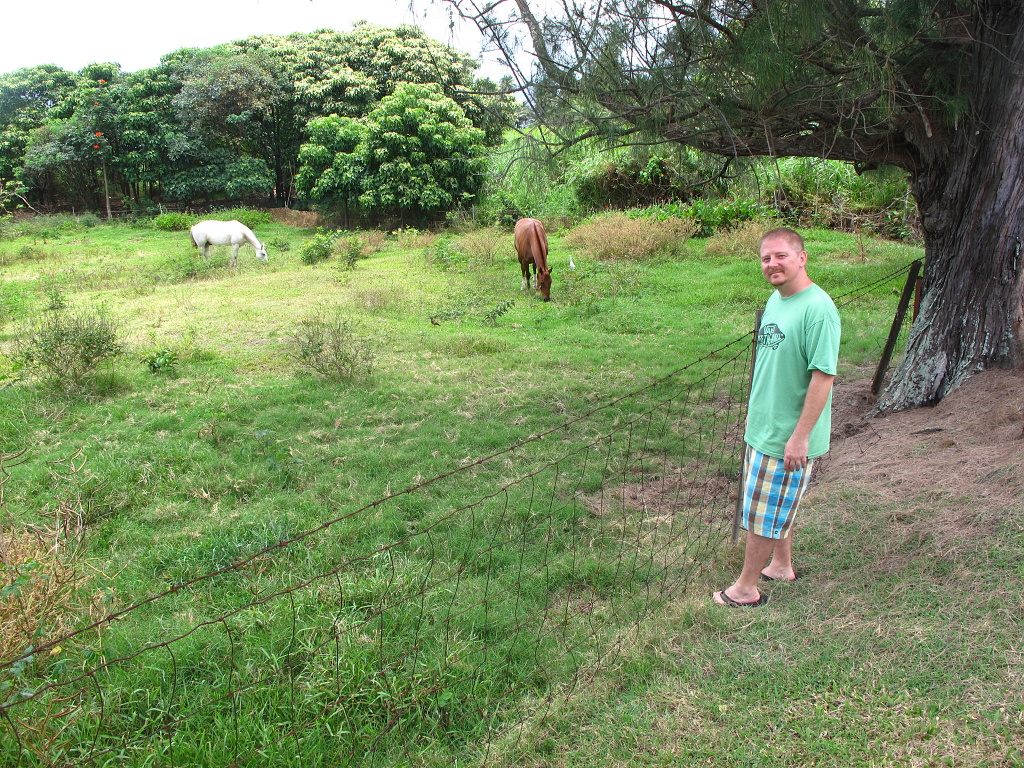
As we continued the few miles back to Kipahulu, we stopped at a waterfall we'd noticed earlier.
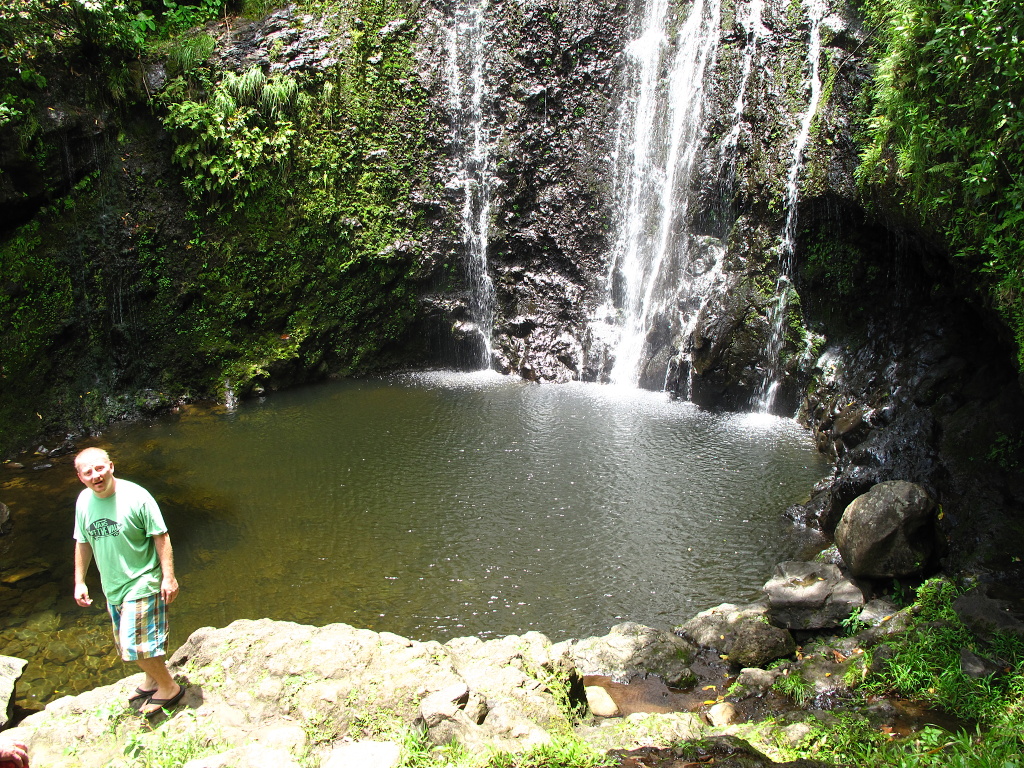
This waterfall had a very curious feature. In the path of the water, someone, presumably a long time ago, had carved a partial block out of the native lava. It was about the size and shape of a coffin. Why? What did it signify? I have no idea, and have been unable to find anything about it on the Internet. If anyone has an explanation, I'd love to hear it!
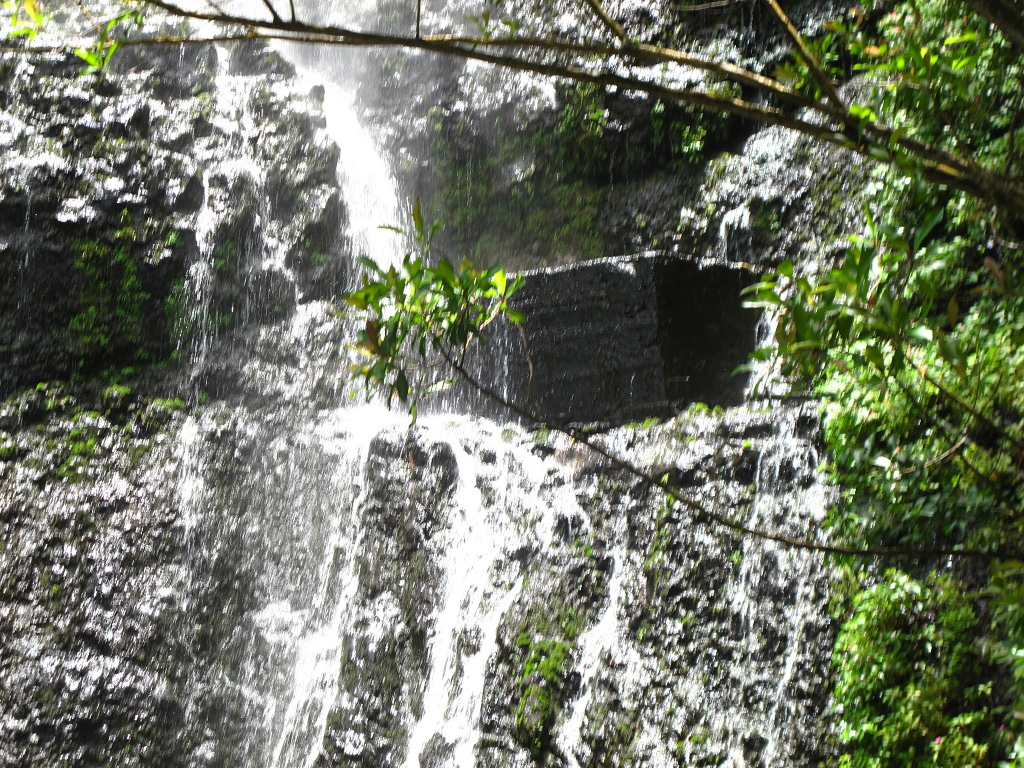
Wanting our own photo taken here, I offered to take another couple's photograph with their camera so they'd return the favor, which they did. The result was Jason's and my very favorite photograph from the entire trip.
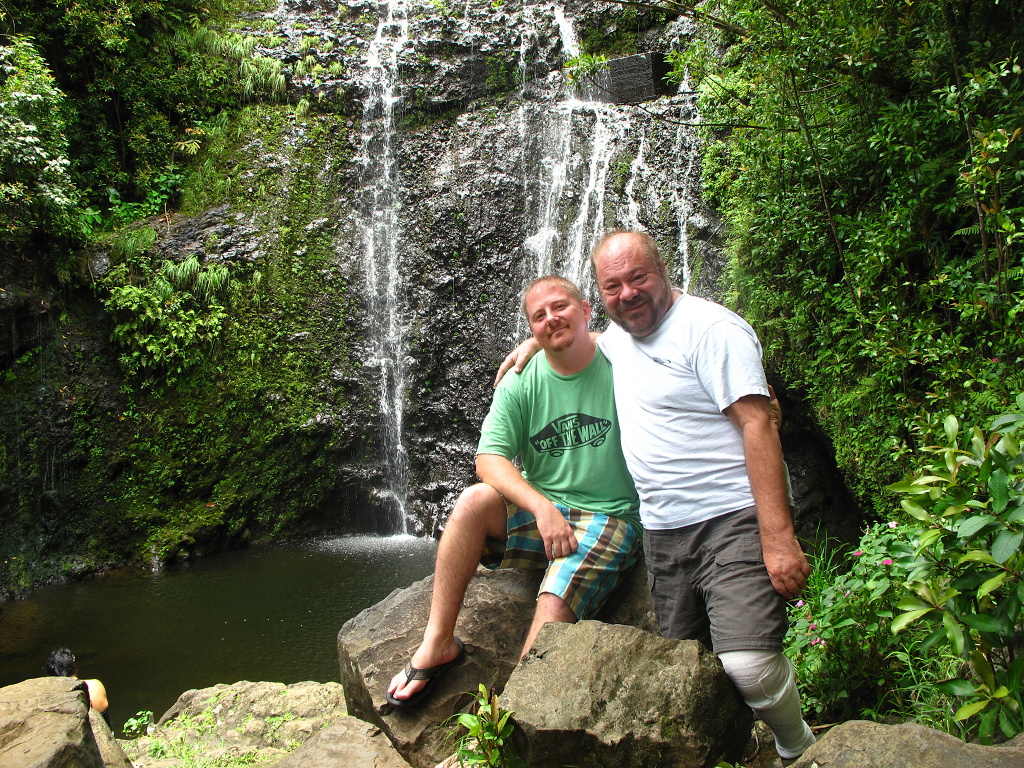
Finally, back at Kipahulu, Jason and I set out to see the things we'd missed while camping here, things accessible from a beautiful and easy-to-walk nature trail. For example, there's a great Banyan tree. Jason and I love trees and are often impressed by them. A Banyan is like a tree of trees; from each branch grows another trunk. Very cool.
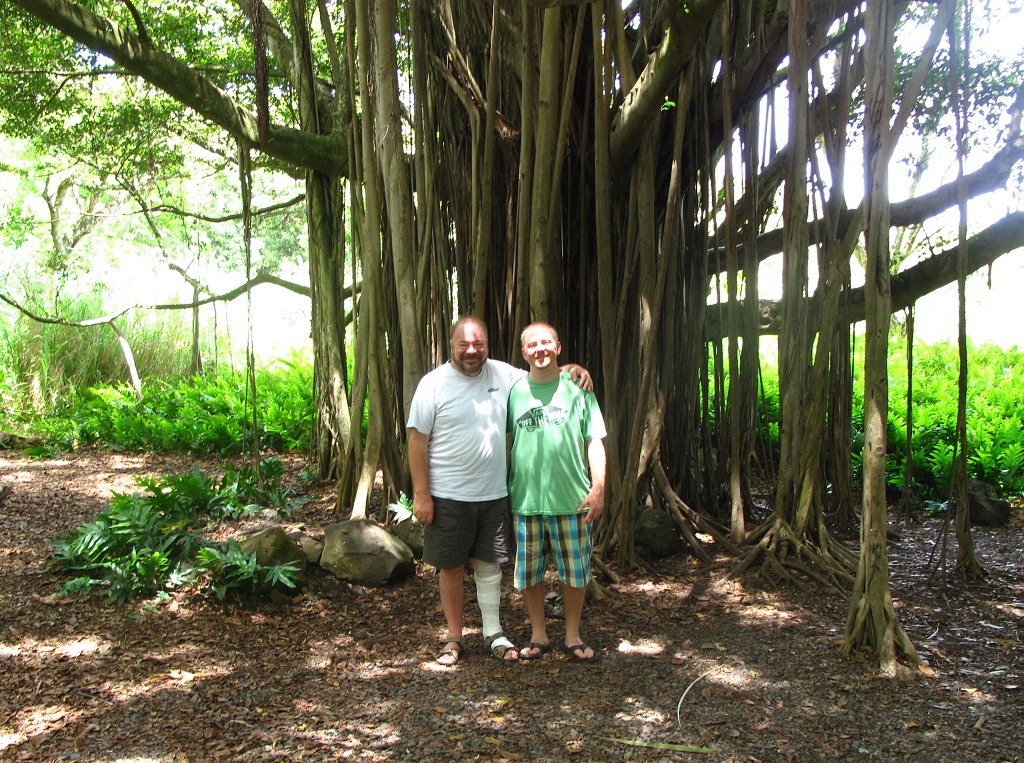
Then there were the Seven Sacred Pools. I couldn't get into them when I was here before, because then it was February and the water was rushing too dangerously fast. And now I couldn't step into one because of my leg (and the seven sacred bacteria the water supposedly contains). But, again, Jason did the honors and stepped into a pool for us both.
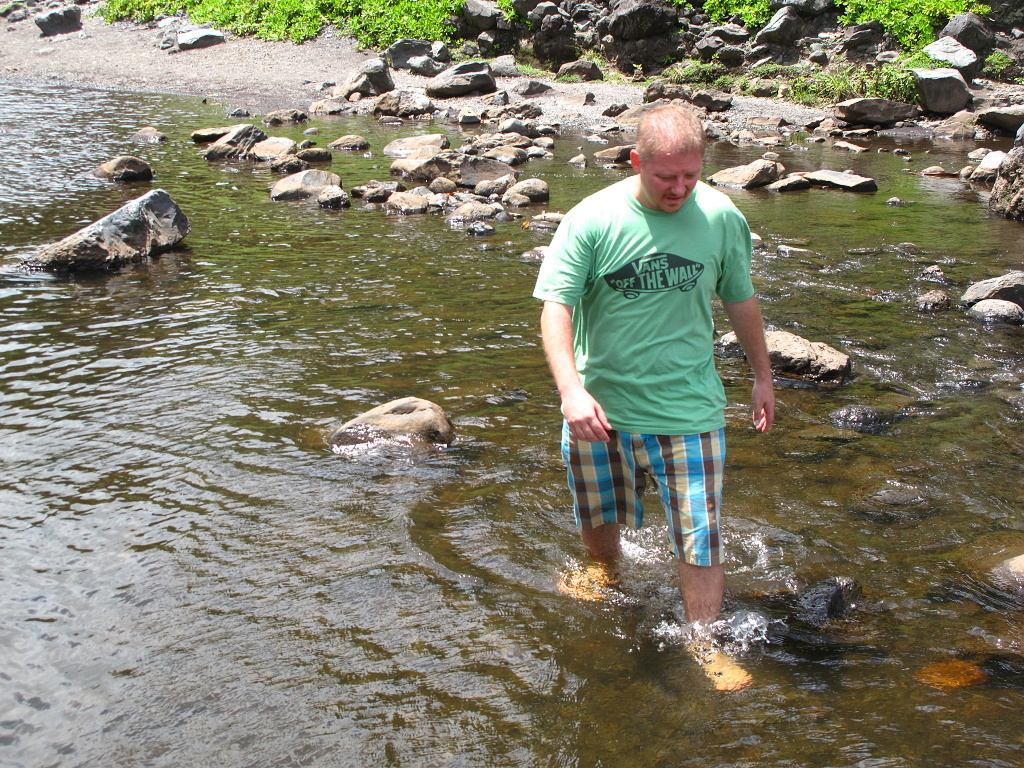
By now the morning was well past us and we decided to move on. I wanted to show Jason the "back" road to Hana, the road less traveled, also known as the Pilani Highway. While this road may not be as "pretty" as the Hana Highway with its innumerable waterfalls and lush greenery, and while the Pilani Highway is certainly less well-maintained (with many lengthy unpaved sections), it is certainly no less spectacular, with countless amazing views (and far less traffic!).
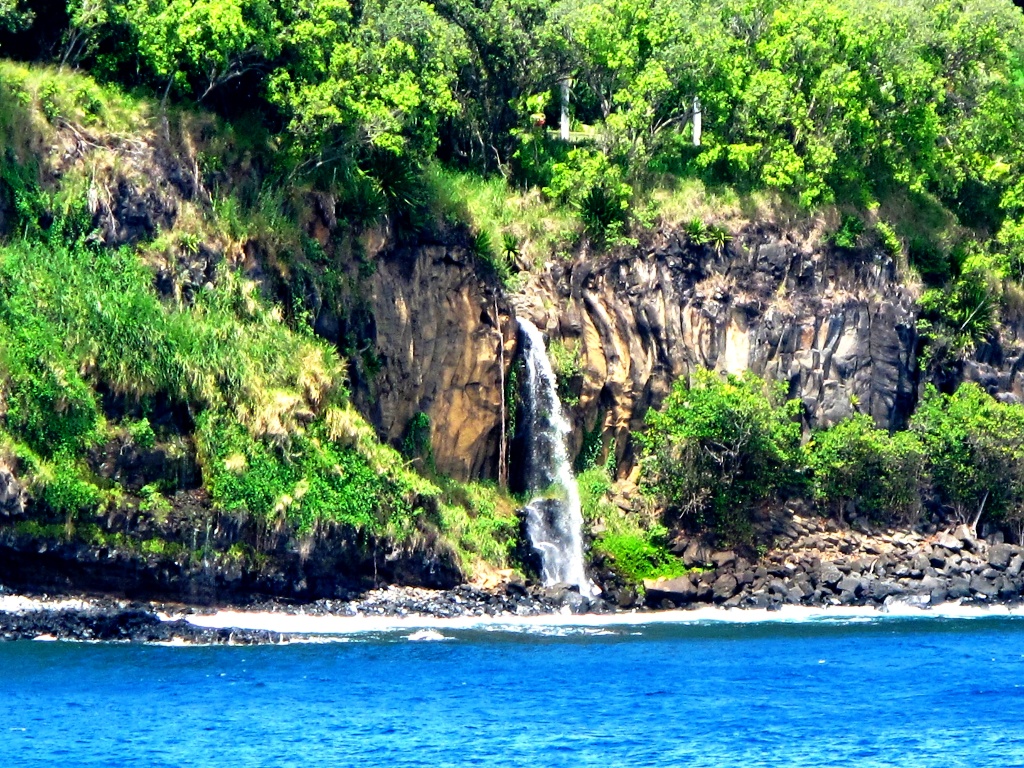
We took some pictures by stopping in the middle of the road and leaning out the window. But there were plenty of turnoffs and we took advantage of them as well. So our average speed, including stops, was probably about 4 mph.
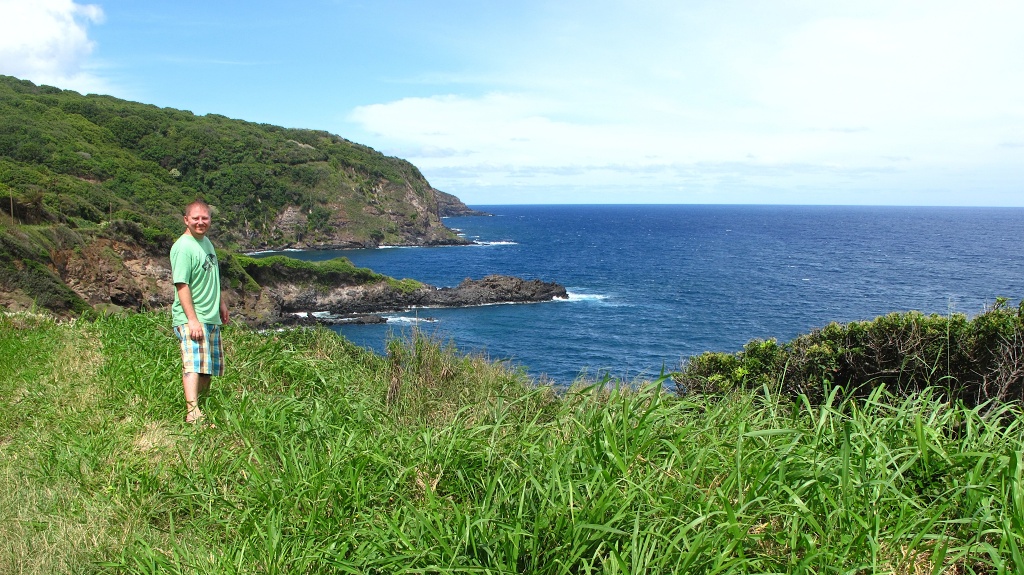
Mighty Mount Haleakala, which forms this side of Maui, is a great weather-maker. By blocking the winds and squeezing the water out of them, it keeps the Hana Coast green and damp. At the same time, the Pilani Coast gets drier as one travels along.
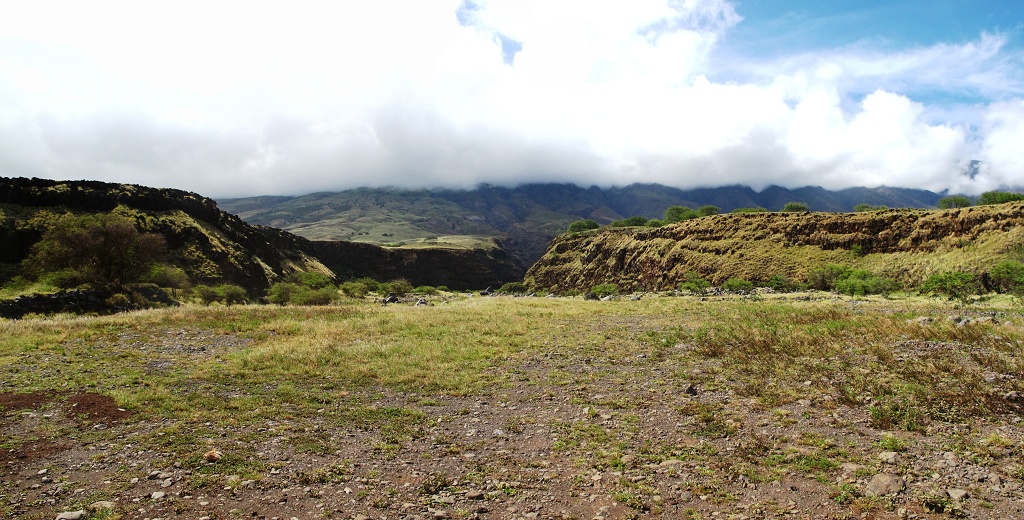
Mount Haleakala is classified as an "active" volcano, even though its last official eruption was in 1790. It does not spout lava from its top; rather, there are three "rifts" along its side from which lava flows when Haleakala erupts. All this relatively new lava lends an additional air of starkness to the coastline, with sheer cliffs and jagged edges the norm.
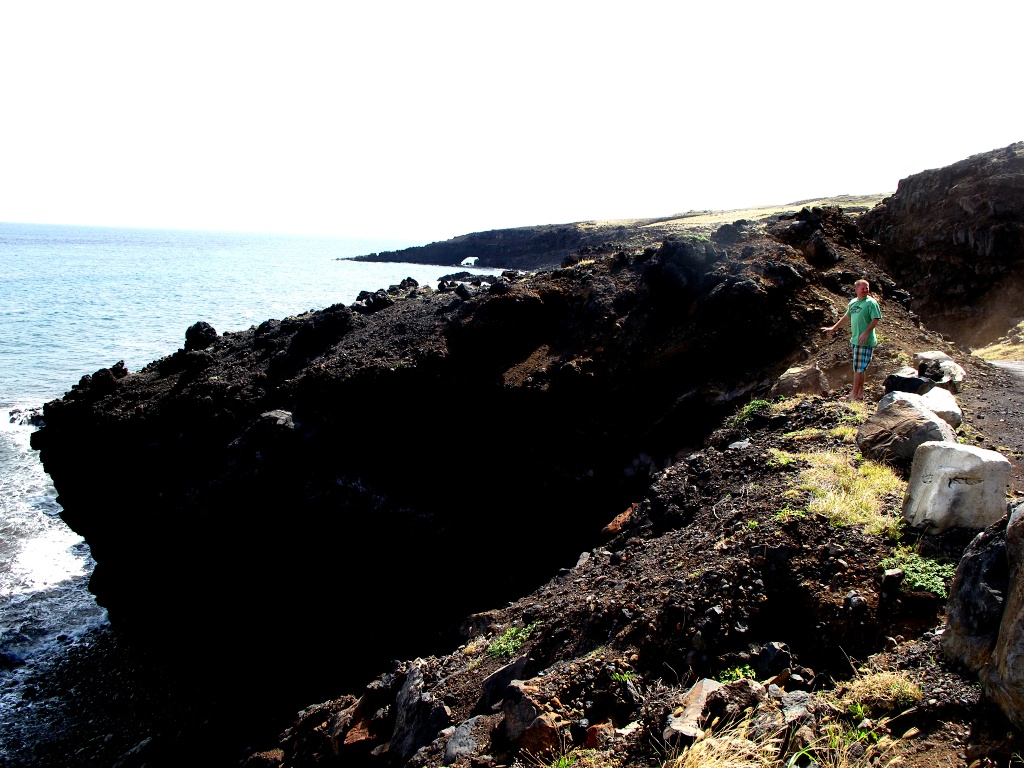
Although Haleakala hasn't erupted in centuries, there are frequent earthquakes, including a large 6.7 on the Richter scale in 2006. And nowhere are the results more visible than along the Pilani Coast.
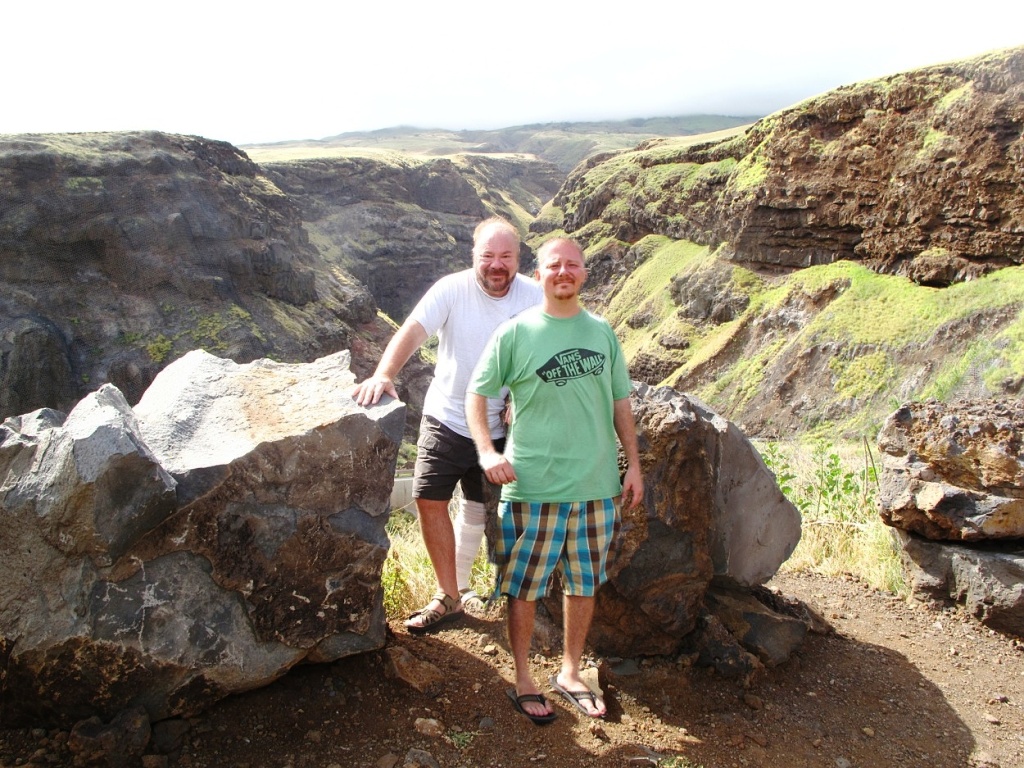
We stopped at the Ulupalakua Country Store hoping for a late lunch; but it was too late: The grill was closed. However, we were able to buy a couple of pints of Haupia ice cream, a coconut pudding flavor that I discovered last year in Kauai. Jason claimed to not like coconut, but he tasted the Haupia and found he loves it as much as I.
Past Ulupalakua, the curve of the road brought the entire island into view, including West Maui and the isthmus in between.
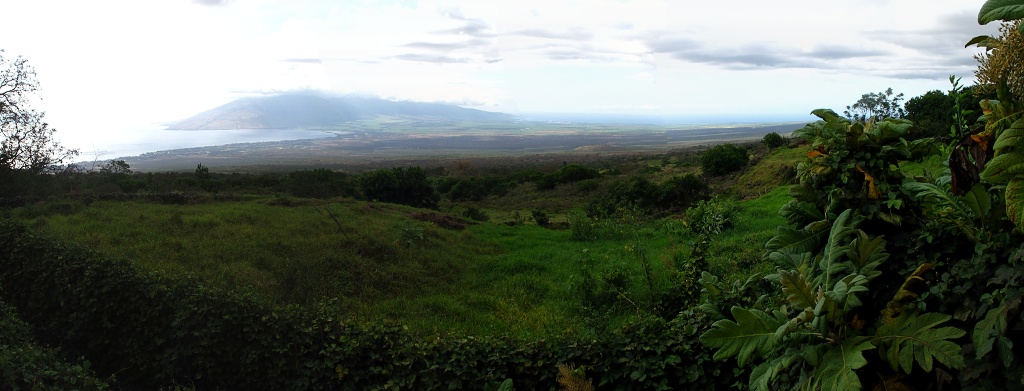
The view was repeated and emphasized as we began to climb up to the summit, nearing the clouds that had kept the summit from view for the past day.
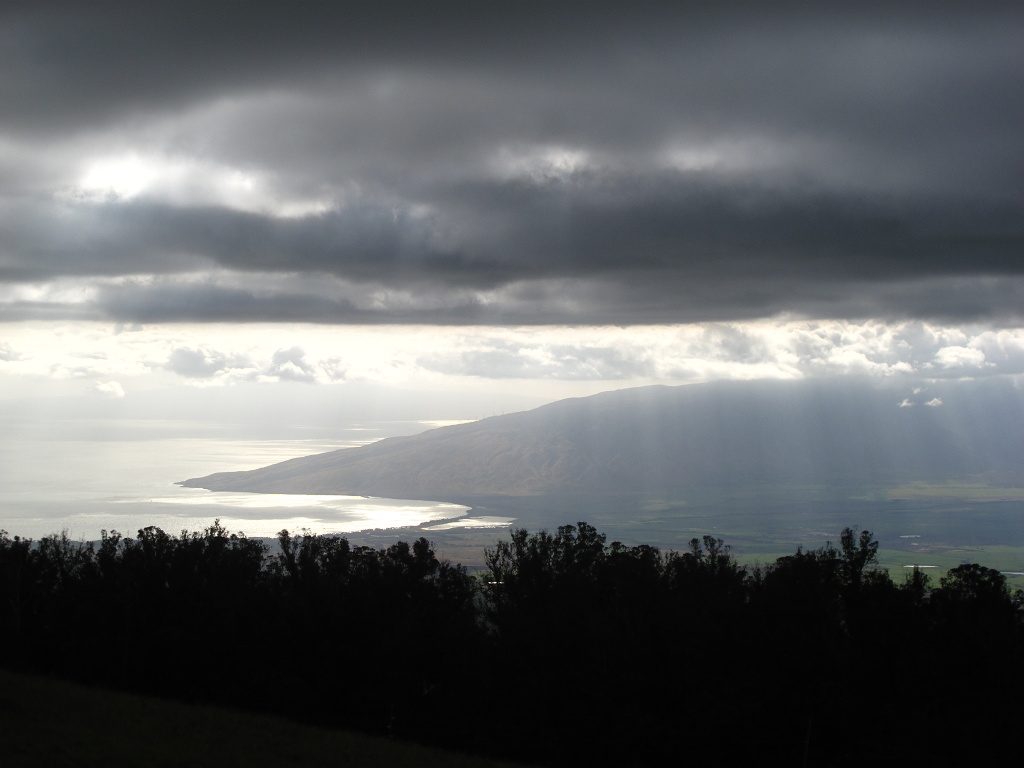
It took hours to drive the relatively short 27 miles up the Haleakala Highway, which is composed of many switchbacks, blind turns, and a low speed limit. We passed Hosmer's Grove, where I camped two years ago, and decided to spend the night there. However, we were anxious to get to the summit before sunset, so kept going. We knew we were nearing the summit when we spotted a cluster of observatories.
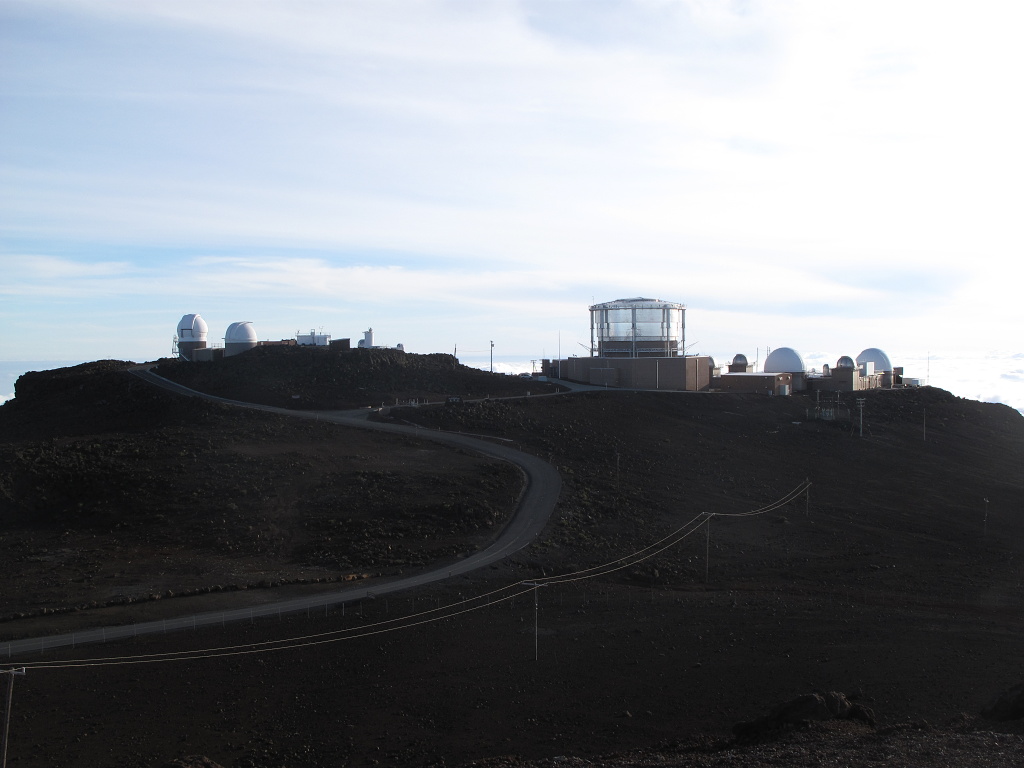
The summit itself, at 10,023 feet above sea level, was nothing less than breathtaking, even before sunset.
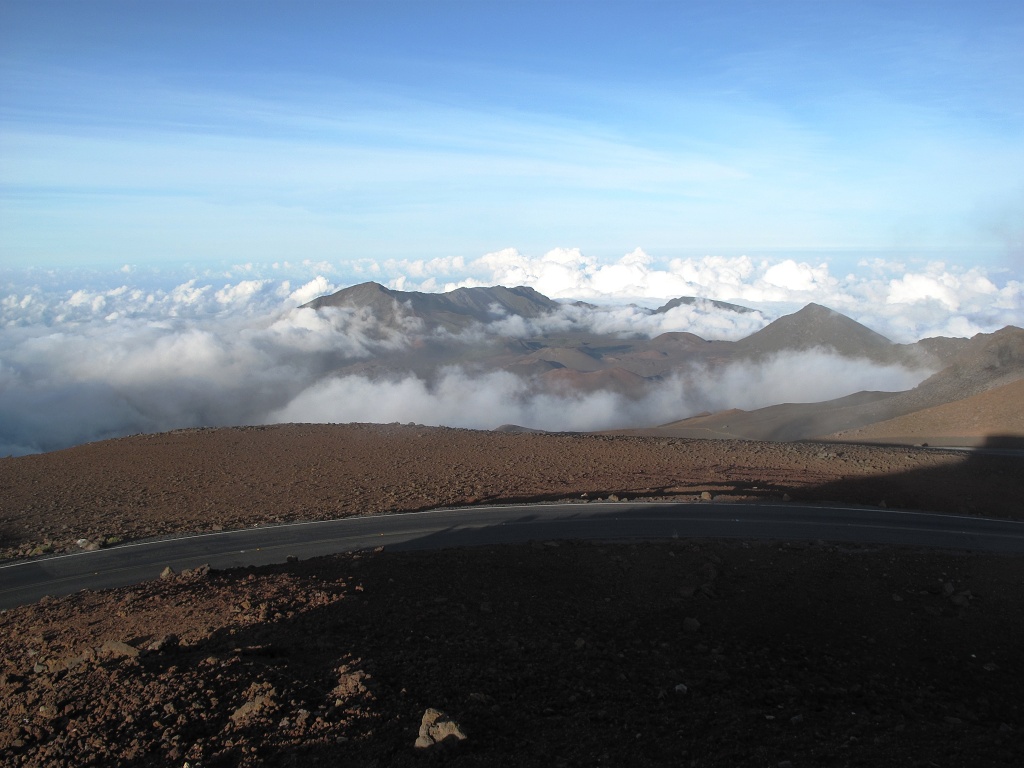
There was an observation booth at the very top, and a ridge on which people were already gathering for the sunset. We could also see the visitor's center (which included restrooms) just below us, though nearly a mile drive by car. The clouds, which were below the peak, drifted over the parking lot like steam pouring over the rim of a teacup.
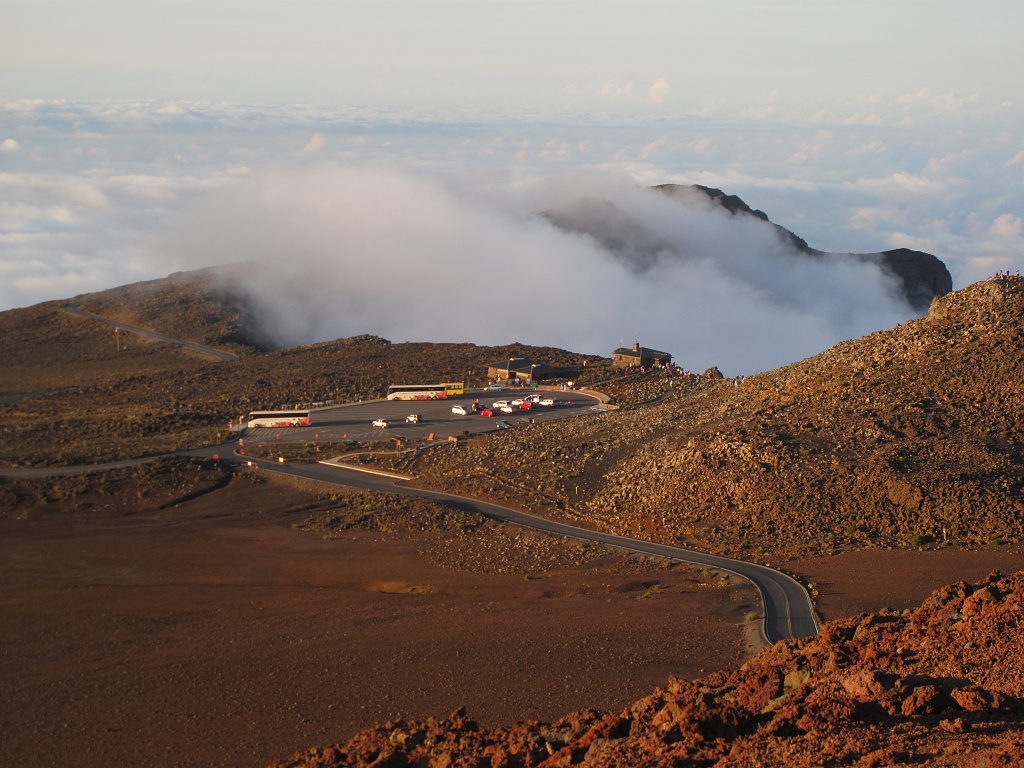
In the East, the nearly-full moon had just risen as if to enjoy the sunset with us mere mortals.
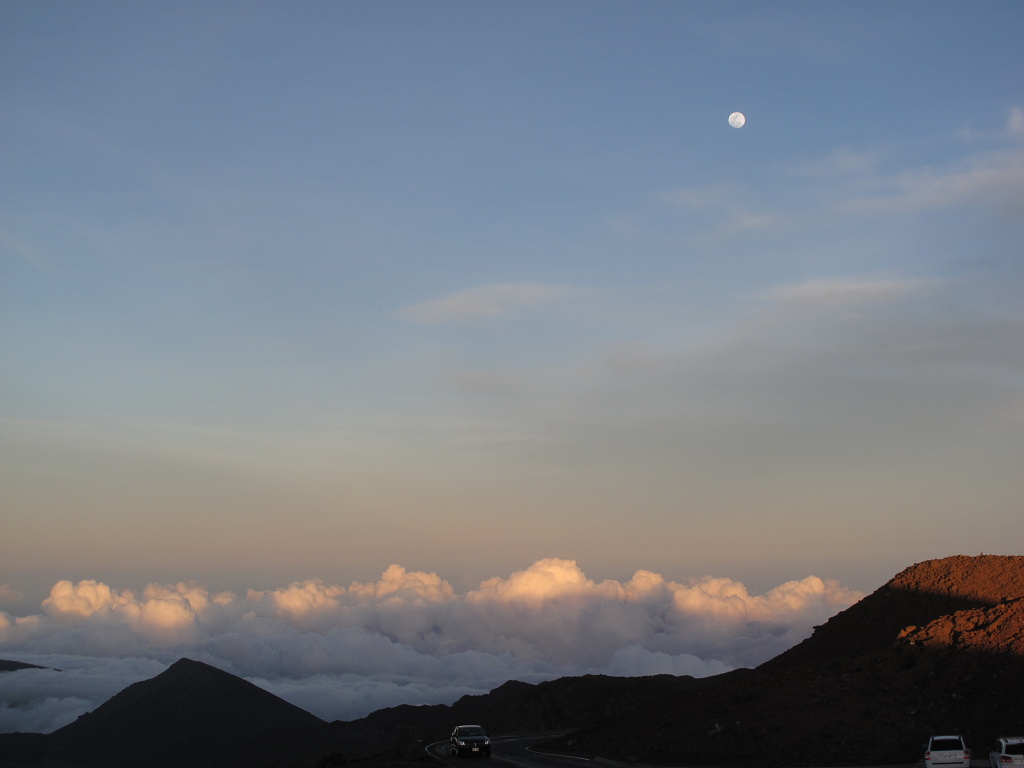
Jason and I took our positions, finding a relatively soft lava ledge to sit on and envying those who had thought to bring camp chairs. The sun, nearing the horizon, took on a ruddy hue. I snapped a shot of Jason, using flash to illuminate him against the brilliance of the setting sun.
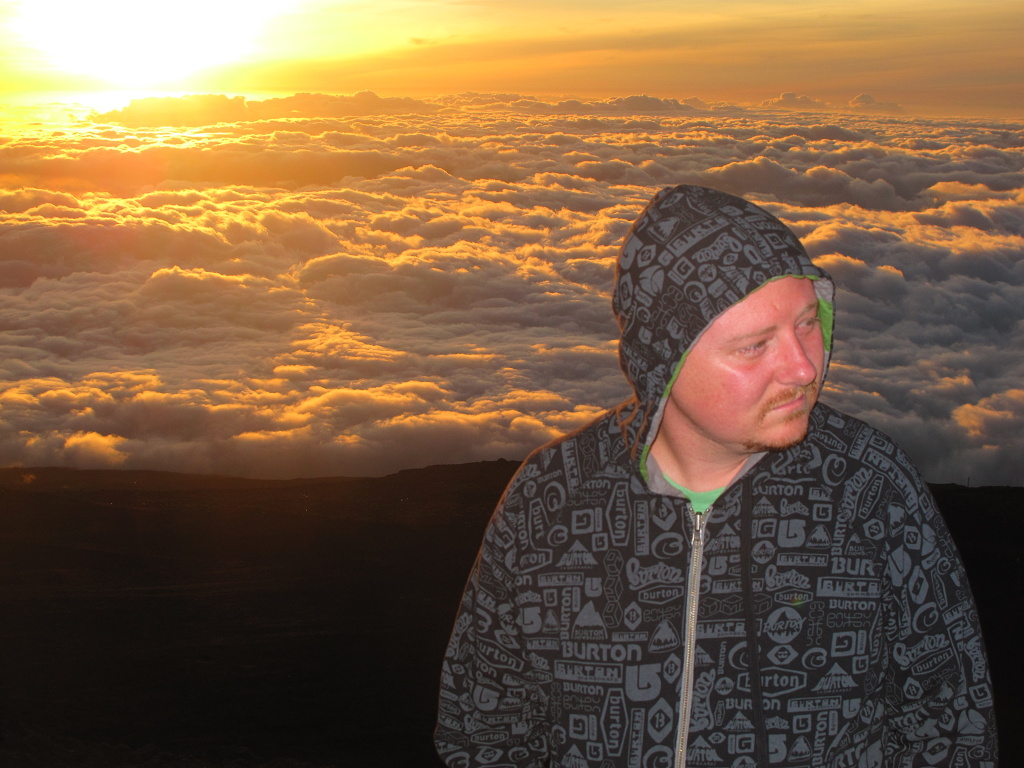
Then we sat in silence, huddling against the chilling wind, rapt as the sun sank beneath the clouds that were, in turn, beneath us.
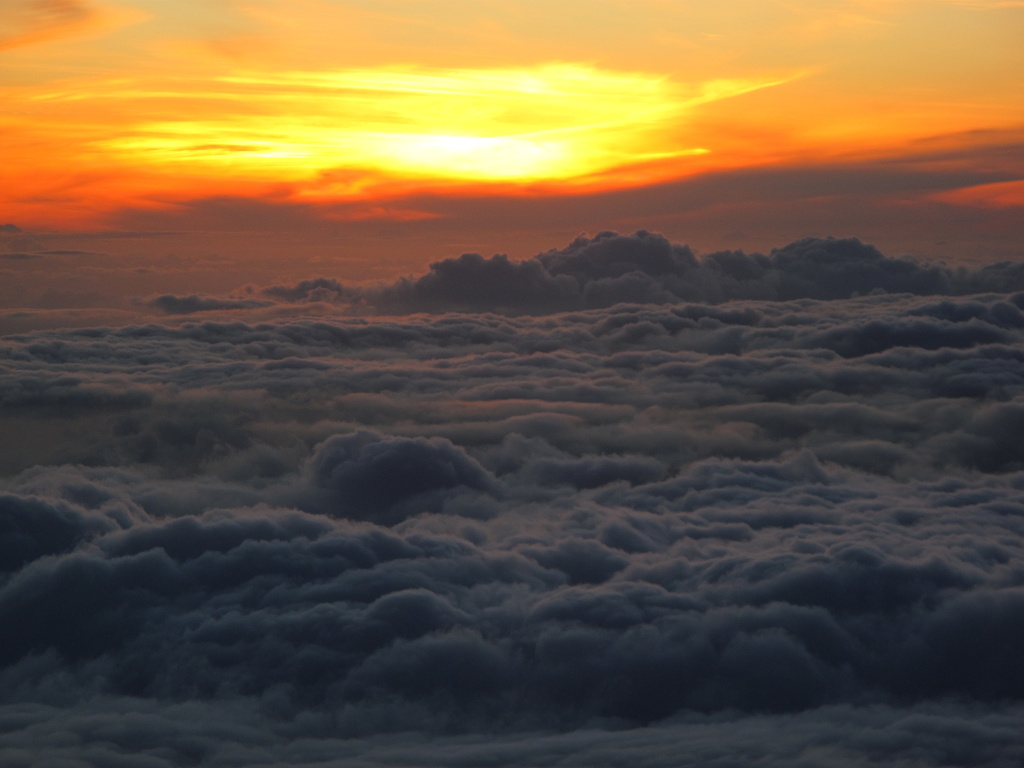
Finally, the show was over. Jason and I returned to our camper by twilight. We intended to return to Hosmer's Grove; but decided to stop at the visitor's center first to use the restroom, habitually locking the doors when we got out.
When we returned, Jason, who had been driving, wanted to get something out of the middle of the camper and inserted the key—our only key—into the lock. Instead of turning, the key twisted and broke.
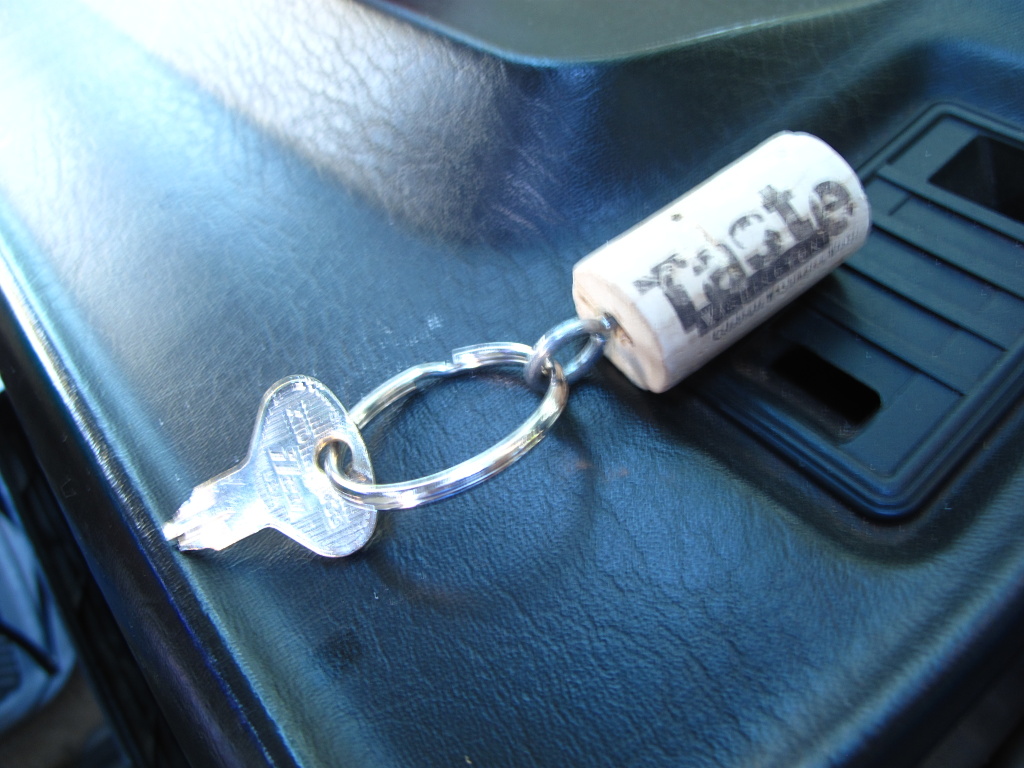
We stared at the key, dumbfounded. How could this happen? "I didn't turn it that hard!" Jason insisted, upset. I agreed, as I had watched him do it. Somehow the key had just disintegrated.
This could be bad. The visitor's center was closed. The camper was locked. There was no cell phone service. The overnight temperature could easily drop to freezing or below.
Then, a miracle occurred. I found that, somehow, I had failed to lock my passenger-side door, even though I remembered doing it. Although we would still be stuck on the summit of Haleakala overnight, at least we would have shelter and something to eat, as we had canned food and a stove and cookware with which to heat it.
Jason and I agreed that most people would get very upset over a situation like this. A lot of people don't seem to be able to handle the unexpected, especially on a vacation, where the unexpected must be expected. However, neither of us were concerned. We knew we would be comfortable enough through the night; we had food and were parked near the rest room should that be needed.
So, after eating, we went to bed, under all our blankets (the camper came with three) and wearing our clothes. We held each other closely and again fell asleep in each other's arms.





